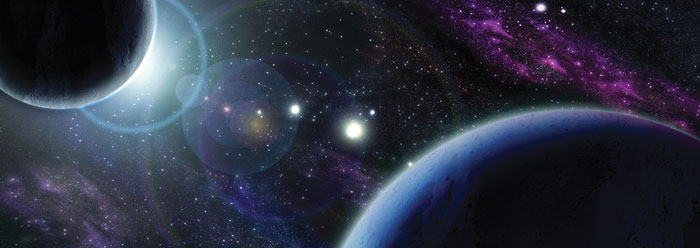Evolutionary philosophy is a bottom-up storytelling project: particles, planets, people. Naturalists (those who say nature is all there is) believe they can invent explanations that are free of miracles, but in practice, miracles pop up everywhere in their stories. This was satirized by Sidney Harris years ago in a cartoon that showed a grad student filling a blackboard with equations. His adviser called attention to one step that needed some elaboration: It said, "Then a miracle hap-pens." Examples of miracles in evolutionary philosophy include the sudden appearance of the universe without cause or explanation, the origin of life, the origin of sex, the origin of animal and plant body plans, and the origin of human consciousness.
An egregious example of appeal to miracle appeared recently in Nature. John Chambers of the Carnegie Institute was commenting on recent ideas about planet formation. Scientists have had a difficult time in their models getting pebble-size rocks to grow into planetesimals (bodies large enough to attract material by gravity, usually kilometers across). New pressure has been put on the models by the realization that small bodies spiral into the star on short timescales (in just a few hundred orbits). So here is their new idea: the pebbles just leaped over the size barrier. Chambers said, "Objects must have grown very rapidly from sub-metre-sized pebbles into 100-km-sized bodies, possibly in a single leap." In the same article, he remarked, "Dust grains coalesced into planetesimals, objects of 1-1,000 km in diameter, through an unknown process."1
Don't miracles involve unknown processes, too? Chambers undoubtedly believes that sufficient natural processes will be found in some future model. But that requires faith. So here we see faith in an unknown process keeping the naturalistic story together. Chambers referred to a paper in Icarus that stated the miracle even more starkly: "Asteroids were born big."2 The authors of that paper explained the miracle in these terms: "The size of solids in the proto-planetary disk 'jumped' from sub-meter scale to multi-kilometer scale, without passing through intermediate values." That is functionally a miracle.
If this were the only example of appealing to a miracle in secular cosmology, it might be forgiven. But miracles are rampant in the evolutionary story. The literature of biological evolution is replete with statements that this or that animal "evolved" whatever complex systems are needed along the way, as if stating it makes it so. It's time to call this what it is: an appeal to miracles, the very concept that Enlightenment science was invented to avoid. It has become the caricature stated in Finagle's 6th Rule of Science: "Do not believe in miracles. Rely on them."
Fred Hoyle used to respond to critics--who regarded his “steady-state” cosmology as unscientific because it required the continuous creation of matter out of nothing--by pointing out that Big Bang cosmology does the same thing; it just creates it all at once. Deduction: everyone believes in miracles. Instead of needing to invoke continual bottom-up miracles in the evolutionary story, creationists get the world right by a top-down miracle of creation. The difference is that the creation miracle was intelligently designed for a purpose.
The top-down approach leads to superior science in two ways. For one, it matches the laws of nature we know. We see asteroids proceeding from the top down--colliding and grinding down into dust, not leaping from dust into planetesimals by some "unknown process." For another, creation science provides the basis for rationality. For science to succeed, it needs a philosophical anchor for the belief that the world is rational and can be understood. The Genesis account of man being created in the image of God provides that anchor.
Rationality in science requires reference to causes necessary and sufficient to produce the effects. If miracles are necessary, then an omnipotent Creator is sufficient. Appealing to chance miracles, however, is no more useful than stating "Stuff happens."3 Creation, the "top-down" method, provides the solid foundation for rational scientific explanation.
References
- Chambers, J. 2009. Planetary science: Archaeology of the asteroid belt. Nature. 460 (7258): 963-964.
- Morbidelli, A. et al. Asteroids Were Born Big. Icarus. Article in press, available online July 16, 2009.
- See Coppedge, D. 2009. "Stuff Happens": A Review of Darwin's Influence on Modern Astronomy. Acts & Facts. 38 (2): 37.
* David Coppedge works in the Cassini Program at the Jet Propulsion Laboratory. The views expressed are his own.
Cite this article: Coppedge, D. 2009. Bottom-Up Science. Acts & Facts. 38 (11): 18.




